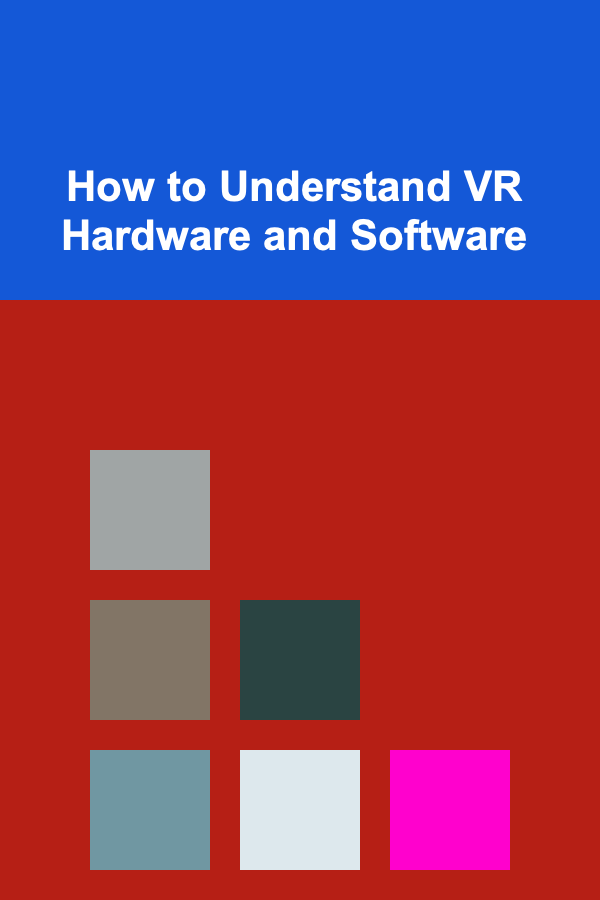
How to Understand VR Hardware and Software
ebook include PDF & Audio bundle (Micro Guide)
$12.99$6.99
Limited Time Offer! Order within the next:

Virtual Reality (VR) has emerged as one of the most transformative technologies of the 21st century, offering a new way of experiencing the digital world through immersive simulations. The appeal of VR spans multiple industries, from entertainment and gaming to healthcare, education, and business. Understanding the hardware and software behind VR is crucial for those who want to engage with the technology, develop VR applications, or simply enhance their user experience. In this article, we will explore the inner workings of both VR hardware and software, breaking down the key components, their functions, and how they work together to create an immersive experience.
What is VR?
Virtual Reality is an interactive 3D environment that simulates a user's presence in a computer-generated world. By using specialized hardware and software, users can interact with virtual objects and navigate through simulated spaces in ways that feel real. While VR experiences can range from games and simulations to architectural visualizations and training environments, the underlying technology is always based on two main components: hardware and software.
In order to understand VR fully, one must grasp the roles of both of these components. This article provides an in-depth look at both.
VR Hardware
The hardware that powers VR experiences is essential in creating the immersive environments we associate with VR. The hardware is responsible for capturing, processing, and displaying the virtual world in a way that the user can perceive as real. VR hardware typically consists of several core elements:
1.1. Headsets
At the heart of the VR experience is the VR headset. It's the primary device that delivers the visual and auditory immersion for the user. Headsets typically include a combination of lenses, display screens, and motion sensors.
- Lenses: Lenses are used to magnify and distort the display so that it appears in three dimensions. These lenses are crucial for simulating depth and creating a sense of immersion. The positioning and curvature of the lenses play a vital role in how realistic and comfortable the VR experience is.
- Display Screens: Modern VR headsets are equipped with high-resolution displays (OLED or LCD) that create crisp, vibrant images. These displays are usually divided into two separate screens (one for each eye) to create a stereoscopic 3D effect, which helps trick the brain into perceiving depth.
- Motion Tracking: The headset includes sensors like accelerometers, gyroscopes, and magnetometers, which track the user's head movements. This tracking allows the virtual environment to adjust in real-time, ensuring that the user's view shifts naturally with their head orientation.
- Field of View (FoV): The FoV refers to how much of the virtual world the user can see at once. A larger FoV results in a more immersive experience, making the user feel as if they are physically present within the virtual world.
- Comfort and Fit: VR headsets are designed with adjustable straps and padding to ensure comfort during long sessions. Over time, more ergonomic designs have emerged, ensuring that users can wear them for extended periods without discomfort.
1.2. Controllers and Input Devices
While the headset provides the visual and auditory immersion, controllers and other input devices allow users to interact with the virtual environment. These devices track hand movements, gestures, and sometimes even body movements.
- Hand Controllers: These are the most common type of input device. They allow users to manipulate virtual objects, perform actions, and move through the VR world. Controllers often include buttons, touchpads, and analog sticks, with sensors to detect their position and orientation in space.
- Motion Tracking: Many VR systems use external sensors or cameras placed around the user's environment to track the movement of controllers. This allows for precise movement and interaction within the virtual world. Some systems also use a technique called inside-out tracking, where cameras on the headset itself track the surroundings.
- Gloves and Haptic Feedback: For more advanced systems, gloves equipped with sensors and haptic feedback can provide tactile sensations. These gloves allow users to feel virtual objects or simulate physical interactions like touch, squeeze, or texture. Haptic feedback provides another layer of immersion by vibrating or providing pressure sensations in response to the virtual world.
1.3. Audio Devices
Sound plays a crucial role in VR immersion, enhancing the sense of presence. Audio systems are designed to simulate 3D spatial sound, so users can hear sounds as if they were coming from specific directions within the virtual world.
- Stereo and Positional Audio: VR systems often feature stereo headphones, which provide two-channel sound, but more advanced systems also include positional audio, allowing for a 360-degree sound experience. Positional audio helps users localize sounds, adding to the sense of realism and spatial awareness.
- Headset Integration: Many modern VR headsets come with built-in audio systems, offering the convenience of an all-in-one solution. These headsets typically offer adjustable sound settings for optimal comfort and immersion.
1.4. Computing Devices
VR hardware also relies heavily on powerful computing devices to process the graphical and sensor data required for real-time interaction. Depending on the VR system, this can include desktop PCs, gaming consoles, or even standalone devices.
- PC and Console Requirements: High-end VR systems like the Oculus Rift, HTC Vive, and PlayStation VR require powerful computing hardware to handle the graphics rendering, motion tracking, and other demanding aspects of VR. A capable GPU (Graphics Processing Unit), high-performance CPU, and ample RAM are crucial for smooth performance.
- Standalone VR Systems: These devices, such as the Oculus Quest, come with built-in computing hardware and don't require an external PC or console. While they offer more portability, their computing power may be somewhat limited compared to high-end PC-based systems.
1.5. Sensors and Cameras
Sensors and cameras are responsible for tracking both the user's movements and the environment in which they interact. These systems ensure that the virtual world responds in real-time as the user moves or adjusts their position.
- External Sensors: Some VR systems use external sensors placed around the play area to capture movement data. These sensors track the user's position and relay that information to the computer, ensuring that the virtual world accurately adjusts based on the user's movements.
- Inside-Out Tracking: Modern VR systems, like the Oculus Quest, use inside-out tracking, where cameras and sensors on the headset itself track the environment. This eliminates the need for external sensors, making it easier to set up and use VR systems.
VR Software
While the hardware creates the foundation for an immersive experience, software is what brings that experience to life. VR software encompasses everything from the operating systems and game engines that run VR applications to the specific VR experiences themselves. Understanding how VR software works is essential to developing VR experiences and creating an interactive virtual environment.
2.1. Operating Systems and SDKs
Like any other computing platform, VR requires a specialized operating system (OS) or software development kit (SDK) that manages hardware resources and facilitates the creation of VR applications.
- VR Platforms: Popular VR platforms like Oculus, SteamVR, and PlayStation VR each have their own ecosystems of games, applications, and experiences. These platforms often provide the software environment where VR applications run and offer developers a set of tools to create content.
- SDKs and APIs: Software Development Kits (SDKs) and Application Programming Interfaces (APIs) are the foundation of VR software development. SDKs provide tools, libraries, and code that enable developers to create VR applications. APIs, on the other hand, allow the software to interact with the underlying hardware, such as sensors, controllers, and displays. Well-known VR SDKs include the Oculus SDK, SteamVR SDK, and Unity's XR Toolkit.
2.2. Game Engines and VR Development
Game engines are the backbone of many VR applications, especially in the gaming industry. These engines enable developers to create immersive, interactive virtual worlds with detailed 3D models, physics simulations, and real-time rendering.
- Unity: Unity is one of the most popular game engines for VR development, offering a wide range of tools and integrations for creating VR experiences. Unity's cross-platform nature makes it suitable for developing applications that run on various VR headsets and devices.
- Unreal Engine: Unreal Engine, developed by Epic Games, is another widely used game engine for VR development. Known for its high-quality graphics rendering and advanced physics simulations, Unreal Engine is often preferred for creating visually stunning VR experiences.
- Other Engines: Other engines like Godot, CryEngine, and Amazon Lumberyard also offer VR support, although they are less commonly used in mainstream VR development.
2.3. Interaction and User Interface (UI) Design
Designing intuitive and user-friendly interactions within VR environments is a unique challenge. Unlike traditional applications, VR requires that user interfaces be fully immersive, allowing for natural interactions with virtual objects.
- Gestural Interaction: In VR, users often interact with the environment through gestures and hand movements, making gesture recognition a key component of VR UI design. Developers must design interfaces that are intuitive and easy to use within the constraints of a 3D virtual space.
- Teleportation and Locomotion: VR experiences often need to simulate movement within the virtual world. This can be done through teleportation (where the user points to a location and "teleports" there) or more complex forms of locomotion like walking, running, or flying. These mechanics are crucial for creating a smooth and comfortable user experience.
2.4. Virtual Environment Creation
At the core of VR experiences are the virtual environments themselves. Creating these environments involves 3D modeling, animation, physics simulations, and lighting effects. The level of detail in the virtual world greatly impacts the immersion and believability of the experience.
- 3D Modeling and Texturing: Creating realistic 3D models of objects, characters, and environments is an essential part of VR development. Tools like Blender, Maya, and 3ds Max are commonly used for modeling and texturing in VR.
- Physics and Interactivity: VR environments need to simulate realistic physics, such as gravity, collision detection, and object manipulation. Game engines like Unity and Unreal Engine include built-in physics systems that developers can use to enhance realism.
- Lighting and Rendering: Lighting is a key factor in creating an immersive VR experience. Proper lighting, shadows, and reflections can make a virtual world feel more lifelike, while poorly implemented lighting can break immersion. Real-time rendering techniques allow the virtual world to change dynamically as the user moves, ensuring that the environment responds to the user's actions.
2.5. Optimization and Performance
VR applications require high-performance rendering and real-time interaction, which puts a significant load on the computing hardware. Optimization is key to ensuring that VR experiences run smoothly and deliver a comfortable experience for users.
- Frame Rate and Latency: High frame rates (at least 90 frames per second) and low latency are essential in VR. Low frame rates and high latency can cause motion sickness and disrupt the immersion. Developers need to optimize the VR experience to maintain a stable frame rate and reduce latency.
- Graphics Optimization: VR experiences require the rendering of two images (one for each eye), which puts extra strain on the hardware. Optimizing textures, lighting, and models ensures that VR applications run smoothly while maintaining visual fidelity.
Conclusion
Understanding VR hardware and software is essential for anyone interested in diving into the world of virtual reality. From the intricacies of VR headsets and controllers to the complexities of game engines and interaction design, there are many elements that contribute to the immersive experience we associate with VR. By understanding how these components work together, users, developers, and enthusiasts can appreciate the depth and potential of this groundbreaking technology.
As VR continues to evolve, the hardware and software supporting it will also advance, opening up new opportunities for innovation and exploration. Whether for gaming, education, or business, VR is poised to change how we interact with the digital world, and a deep understanding of its components is the first step toward harnessing its full potential.

How to Implement Companion Planting for a Thriving Garden
Read More
How to Set Up a Seasonal Clothing Swap with Friends
Read More
How to Utilize Smart Dust and Sensor Networks
Read More
How To Use Ear Candling for Wellness
Read More
How to Develop Resilience as an Entrepreneur
Read More
How to Bake Like a Professional Pastry Chef
Read MoreOther Products

How to Implement Companion Planting for a Thriving Garden
Read More
How to Set Up a Seasonal Clothing Swap with Friends
Read More
How to Utilize Smart Dust and Sensor Networks
Read More
How To Use Ear Candling for Wellness
Read More
How to Develop Resilience as an Entrepreneur
Read More